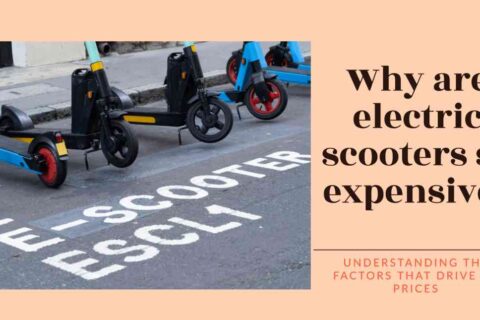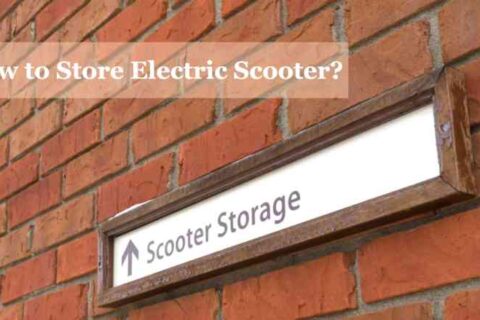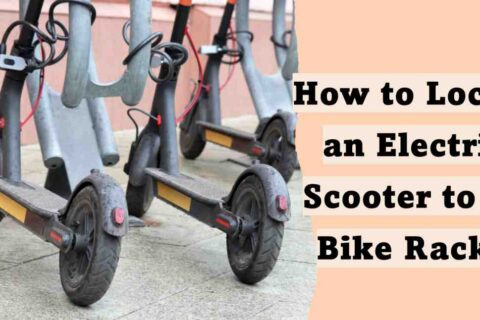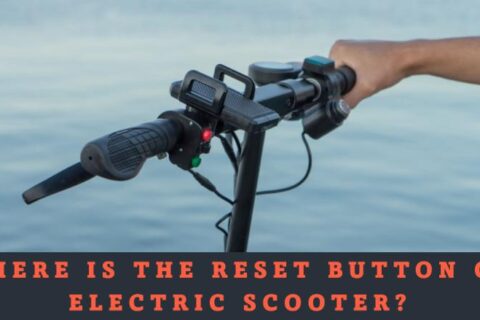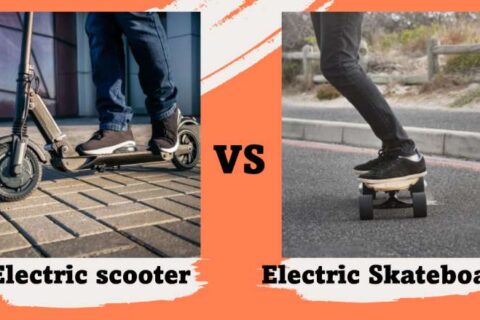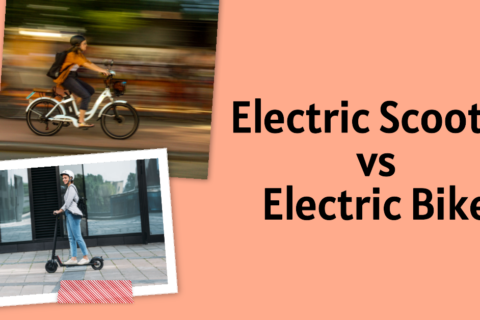Electric scooters have become increasingly popular as a convenient and eco-friendly mode of transportation. One of the most common questions that arise is, “How much electricity does electric scooter use?”
The answer to this question depends on various factors, such as the battery capacity, charging efficiency, and the electric scooter’s energy consumption.
Let’s check the steps and formulas to know the answer.
Certainly, here’s the key takeaway section presented in a table format:
| Key Takeaways |
|---|
| 1. Calculate electricity consumption based on battery capacity and charging efficiency. |
| 2. Determine electricity cost per mile with local rates and consider using Eco Mode for savings. |
| 3. Your riding style matters; smooth acceleration and gradual braking reduce energy use. |
| 4. Maintain battery health for optimal energy efficiency. |
| 5. Understanding consumption helps maximize efficiency and make eco-friendly choices. |

Table of Contents
ToggleHow to Calculate the Electricity Consumption of Your Electric Scooter?
Understanding the electricity consumption of your electric scooter is essential for budgeting, estimating range, and overall energy efficiency. To calculate the electricity consumption of your electric scooter, follow these steps:
- Gather Information:
First, you need to collect some essential information about your electric scooter. Find the battery capacity (in watt-hours) from the manufacturer’s specifications or user manual. For example, if your scooter has a 350-watt-hour battery, take note of it. - Determine Charging Efficiency:
Determine the charging efficiency of your electric scooter, which is typically expressed as a percentage. Charging efficiency represents how much energy is lost during the charging process. For example, if your scooter’s charging efficiency is 90%, it means 10% of the energy is lost during charging. - Calculate Required Energy for Full Charge:
To calculate the energy required for a full charge, divide the battery capacity by the charging efficiency. Using the example above: 350 watt-hours / 0.9 (90% charging efficiency) = 388.89 watt-hours. - Convert to Kilowatt-Hours:
Convert the watt-hours to kilowatt-hours (kWh) by dividing by 1,000. In our example: 388.89 watt-hours / 1000 = 0.38889 kWh. - Determine Energy Efficiency:
To find the energy efficiency of your electric scooter, you’ll need to know its range on a fully charged battery. For instance, if your scooter can travel 20 miles on a full charge, divide the battery capacity by the range: 350 watt-hours / 20 miles = 17.5 watt-hours per mile. - Estimate Electricity Consumption:
Now that you have the energy efficiency (watt-hours per mile), you can estimate the electricity consumption for specific distances. For example, if you plan to travel 5 miles, multiply the energy efficiency by the distance: 17.5 watt-hours/mile x 5 miles = 87.5 watt-hours. - Cost Calculation:
To calculate the cost, multiply the estimated electricity consumption in kilowatt-hours by your local electricity rate. If your local rate is $0.15 per kWh, then the cost of traveling 5 miles would be: 0.0875 kWh x $0.15 = $0.0131. - Consider External Factors:
Keep in mind that real-world conditions can affect electricity consumption. Factors like rider weight, terrain, weather, and speed can impact energy efficiency. Regular maintenance and proper tire inflation can also help optimize energy usage.
Keep in mind that the electricity cost per mile may vary depending on your electric scooter’s energy efficiency and the local electricity rate.

How much electricity does electric scooter use?
To estimate the electricity usage for charging an electric scooter, we need to know the battery’s watt-hour rating. This rating represents the total energy capacity of the battery and how long you can ride with this battery capacity.
For instance, if your electric scooter has a 300-watt-hour battery, it means it can draw 300 watts of power for one hour or 150 watts for two hours.
The actual electricity consumption during charging may be slightly higher than the battery capacity due to charging losses. Charging losses occur due to the conversion of electricity from the power outlet to the battery, resulting in some energy loss as heat.
On average, these losses can range from 5% to 15%, depending on the charging method and charger efficiency.
Next, we need to consider the local electricity rate to calculate the cost of charging. Electricity prices vary by region, but the average cost is around $0.12 to $0.20 per kilowatt-hour (kWh). Using this rate, we can estimate the cost of charging an electric scooter.
For example, let’s say your electric scooter has a 300-watt-hour battery, and the charging efficiency is 90%. To charge the scooter fully, it would require approximately 333 watt-hours (300/0.9). Converting this to kilowatt-hours, it comes out to 0.333 kWh.
At an electricity rate of $0.15 per kWh, charging your electric scooter fully would cost around $0.05 (0.333 kWh x $0.15).
This cost is relatively low compared to traditional gasoline-powered vehicles, making electric scooters an economical and environmentally friendly choice for short-distance commuting.

What is the average electricity cost per mile for an electric scooter?
To determine the electricity cost per mile, you need to consider two main factors: the energy consumption of the electric scooter and the local electricity rate.
First, let’s calculate the energy consumption. Suppose you have a 300-watt-hour battery, and the charging efficiency is 90%. As mentioned in the previous article, charging your electric scooter fully requires approximately 333 watt-hours (300/0.9). Converting this to kilowatt-hours, it is 0.333 kWh.
Now, you need to know the electric scooter’s energy efficiency or watt-hours per mile. Let’s assume your electric scooter can travel 20 miles on a fully charged battery. To find the watt-hours per mile, divide the battery capacity by the range: 300 watt-hours / 20 miles = 15 watt-hours per mile.
Next, consider the local electricity rate. As mentioned earlier, the average cost per kilowatt-hour is around $0.15 to $0.20. To calculate the electricity cost per mile, divide the watt-hours per mile by 1,000 to get the kilowatt-hours per mile: 15 watt-hours/mile / 1000 = 0.015 kWh/mile.
Now, multiply the kilowatt-hours per mile by the electricity rate to get the average electricity cost per mile: 0.015 kWh/mile x $0.15 = $0.00225.
So, the average electricity cost per mile for your electric scooter is approximately $0.00225.
Can Using Eco Mode Save Electricity on Electric Scooters?
Eco Mode, also known as energy-saving mode, is a feature found in many electric scooter models. When activated, this mode optimizes the scooter’s performance to achieve maximum energy efficiency.
Here’s how Eco Mode works and how it can save electricity:
- Power Optimization: In Eco Mode, the scooter’s motor output is often limited, which reduces the power consumption during acceleration and cruising. This controlled power delivery helps conserve energy and extends the battery life.
- Reduced Maximum Speed: Eco Mode may cap the scooter’s maximum speed to a lower value compared to regular modes. Slower speeds generally consume less electricity, as overcoming air resistance requires less power.
- Regenerative Braking: Some Eco Modes enable regenerative braking, which captures and converts kinetic energy back into electricity during braking. This regenerative feature helps recover some energy that would otherwise be lost during braking, enhancing overall energy efficiency.
- Smoothing Acceleration: Eco Mode often encourages smoother and more gradual acceleration, minimizing sudden power surges that can lead to higher energy consumption.
TIPS:
Using Eco Mode, riders can achieve energy savings of around 10-20%, depending on the specific scooter model and riding conditions.

How Riding Style Affects Electricity Consumption?
How you accelerate, brake, and maintain your speed can have a substantial impact on the scooter’s energy efficiency and overall range. Here’s how riding style can influence electricity consumption:
Smooth Acceleration – Gradual and smooth acceleration is more energy-efficient than rapid and aggressive acceleration. When you accelerate gently, the motor draws power more steadily, consuming less electricity per unit of distance traveled.
Braking Habits – Frequent and sudden braking wastes energy and reduces the effectiveness of regenerative braking, if available. Anticipate traffic conditions and use gradual braking when possible to maximize energy recovery through regenerative braking.
Steady Speed – Maintaining a steady speed once you reach your desired velocity is more efficient than constantly speeding up and slowing down. Minimizing speed fluctuations reduces energy consumption.
Avoid Excessive Speed – Riding at high speeds increases air resistance, which requires more power to overcome. As a result, electricity consumption rises significantly when riding at higher speeds.
Upgrading to Eco Mode – If your electric scooter has an Eco Mode or energy-saving mode, consider using it to automatically optimize your riding style for better energy efficiency.
Weight Distribution – Balance your weight evenly on the scooter to help maintain stability and reduce the strain on the motor, resulting in better energy efficiency.
Plan Your Routes – Avoid routes with frequent stops and starts or steep inclines if possible. Planning efficient routes can help optimize energy consumption and extend your scooter’s range.
Terrain Consideration – Adjust your riding style based on the terrain. For example, on uphill sections, moderate your speed to conserve energy, and on downhill sections, use regenerative braking to recover energy.
Avoid Overloading – Carrying excessive cargo or heavy backpacks can strain the motor and battery, reducing energy efficiency.
Practice Energy-Conscious Habits – Cultivate energy-conscious habits by paying attention to your scooter’s energy consumption and making adjustments as needed. By being mindful of your riding style, you can make significant savings on electricity costs and extend your scooter’s range.
Frequently Asked Questions (FAQs)
How is electricity consumption measured for electric scooters?
Electricity consumption for electric scooters is measured in watt-hours (Wh) or kilowatt-hours (kWh), representing the amount of electrical energy required to power the scooter.
What factors influence the electricity consumption of electric scooters?
Several factors influence electricity consumption, including battery capacity, energy efficiency, rider weight, terrain, speed, and weather conditions. Adopting an energy-conscious riding style can also make a difference.
How do I calculate the electricity consumption of my electric scooter?
To calculate electricity consumption, use the formula:
Electricity Consumption (Wh) = [Battery Capacity (Wh) / Energy Efficiency (Wh/mi) * Distance Traveled (mi)].
What is the average energy efficiency of electric scooters?
The average energy efficiency of electric scooters is typically between 10 to 20 Wh/mi or 6 to 12 kWh/km. This means they consume approximately 10 to 20 watt-hours of electricity to travel one mile.
How far can an electric scooter travel on a full charge?
The range of an electric scooter on a full charge depends on battery capacity and energy efficiency. For example, a scooter with a 200 Wh battery and 10 Wh/mi efficiency can travel approximately 20 miles on a full charge.
Can using Eco Mode save electricity on electric scooters?
Yes, using Eco Mode can save electricity and extend the scooter’s range. Eco Mode optimizes performance for maximum energy efficiency by limiting power output and reducing maximum speed.
How does battery health affect electricity consumption?
Battery health affects electricity consumption by influencing capacity, charging efficiency, and internal resistance. Proper maintenance and charging practices can optimize battery performance and energy efficiency.
Conclusion
Understanding How much electricity does electric scooter use influence electricity consumption and range can help users make informed decisions, maximize energy efficiency, and manage their scooter’s performance effectively.
By measuring electricity consumption in watt-hours or kilowatt-hours, considering factors like battery capacity, energy efficiency, rider’s weight, terrain, speed, and weather conditions, riders can estimate their scooter’s energy needs for various trips.
Utilizing Eco Mode can lead to significant electricity savings, as it optimizes the scooter’s performance for maximum energy efficiency. Additionally, regenerative braking can further enhance energy conservation by recapturing and converting kinetic energy back into electricity during braking.
Riding style plays a pivotal role in electricity consumption. Smooth acceleration, gradual braking, steady speed, and energy-conscious habits can all lead to significant savings on electricity costs and maximize the scooter’s range.
.



